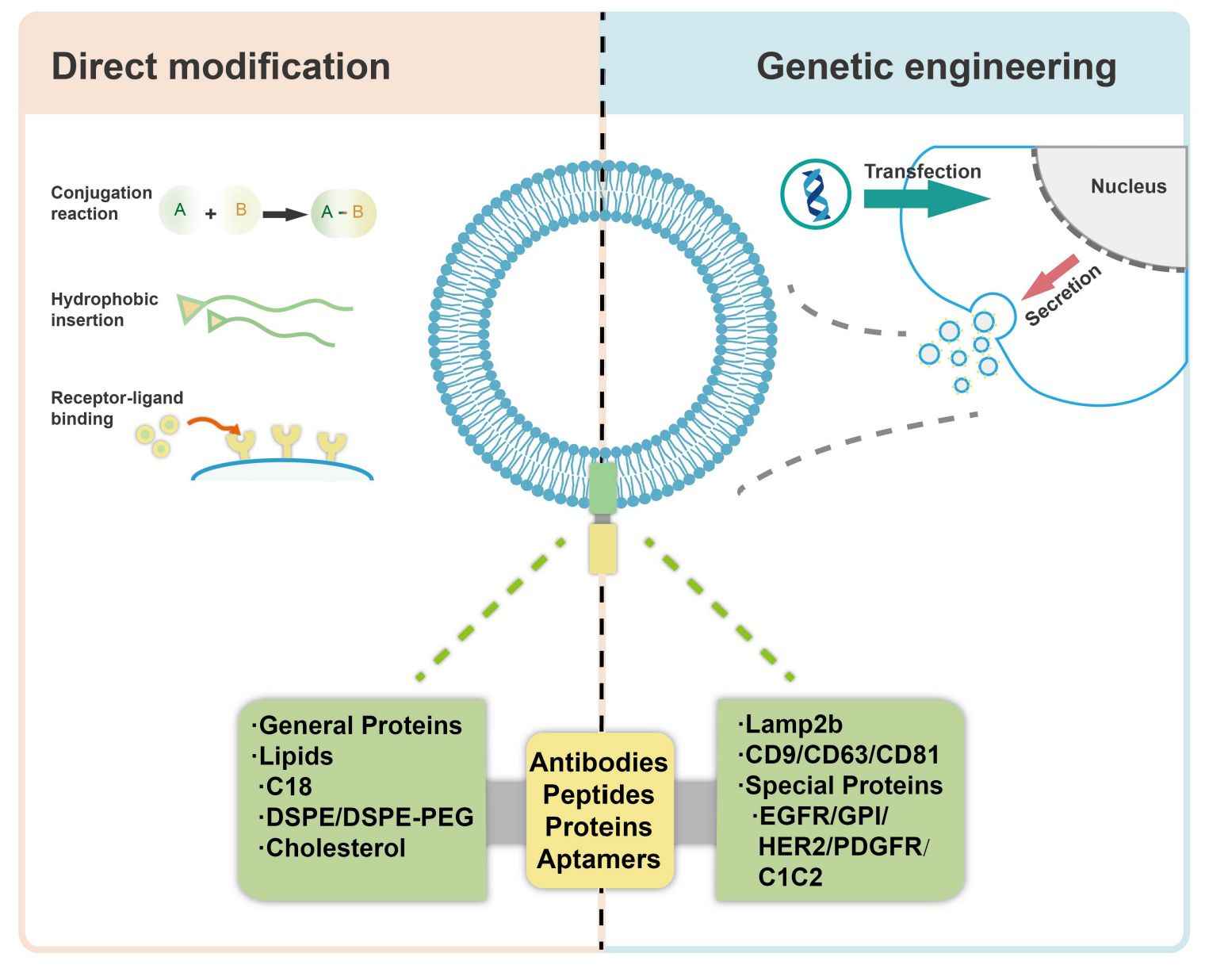How do Exosomes Target Delivery?
In recent years, exosomes as therapeutic drugs or carriers have gradually become a hot spot of attention. Exosomes are a kind of extracellular vesicle secreted by almost all cells and involved in intercellular communication. As nanocarriers, exosomes have certain natural targeting properties and have a broad application prospect in the field of precision medicine. To improve the targeting specificity of exosomes to specific tissues or organs, the mainstream approach is to modify the surface of exosomes.
 Figure 1. Strategies for exosome membrane modification and targeted delivery. (Liu Q, et al., 2023)
Figure 1. Strategies for exosome membrane modification and targeted delivery. (Liu Q, et al., 2023)
Why Target Modification of Exosomes?
Exosomes have a unique ability to penetrate biological barriers and are expected to be used as nanocarriers for various therapeutic applications. However, sometimes insufficient targeting ability limits clinical application, and thus cutting-edge strategies are needed to improve its efficacy. To enhance tissue-specific targeting ability, the engineering of exosomes is required.
Enhance Specificity
- Enhances the target specificity of exosomes to specific cell types or target tissues, thereby improving payload delivery.
- Increases drug accumulation at the target site and reduces off-target effects.
Improve Pharmacokinetics
- Optimize biodistribution of exosomes, reducing systemic distribution and potential side effects.
- Improve drug exposure at the site of action and enhance therapeutic efficacy.
Reduce Immunogenicity and Improve Safety
- Further reduces the immunogenicity of exosomes and mitigates potential adverse immune reactions.
- Improved safety is essential for chronic disease therapy development.
Exosome Targeting Strategies
In order to deliver exosomes to specific cells or tissues, passive or active targeting strategies can be employed. Passive targeting of exosomes utilizes the natural cellular tropism of exosomes, while active targeting involves modification of the exosome surface by physicochemical technologies.
 Figure 2. Modification of exosomes for targeted delivery by direct and indirect methods. (Chen H, et al., 2021)
Figure 2. Modification of exosomes for targeted delivery by direct and indirect methods. (Chen H, et al., 2021)
| Methods | Detail | Advantages | Limitations |
| Genetic Engineering | Genetic engineering is a convenient method for conferring novel properties on exosomes. It fuses a ligand or homing peptide to a transmembrane protein on the surface of the exosome, transfects donor cells with a plasmid encoding the fusion protein, and the donor cells produce exosomes expressing the targeted portion through a natural biogenesis process. |
|
|
| Chemical Modification | Chemical modification refers to the attachment of target proteins to the exosome surface via lipid-binding proteins, membrane-binding proteins, or lipid interactions. |
|
|
| Physical Modification | Physical modification refers to the stimulation of exosomes by physical stimulation (including electric field, ultrasound, magnetic field, etc.), which in turn regulates the expression of proteins on the surface of exosomes. |
|
|
Application
- Drug Delivery - Exosomes with targeted ligands or specific molecules to serve as effective carriers for targeted drug delivery.
- Therapeutics - Modified exosomes can be used as therapeutic agents for the treatment of various diseases and conditions.
- Diagnostic Tools - Exosomes carry specific biomarkers that can be used for liquid biopsies and diagnostic imaging.
- Personalized Medicine - Targeted modification allows exosomes to be tailored to requirements, thereby suggesting personalized treatment strategies.
By providing exosome targeting services, Creative Biostructure helps clients develop innovative exosome drug delivery systems that enhance drug targeting and therapeutic potential.
Before exosome engineering, it is essential to select appropriate exosomes as a starting point for research. We offer exosome products from different sources designed to advance exosome-based diagnostic and therapeutic research. Please feel free to contact us for a formal quote.
References
- Liu Q, et al. Targeted therapy using engineered extracellular vesicles: principles and strategies for membrane modification. J Nanobiotechnology. 2023. 21(1): 334.
- Chen H, et al. Exosomes, a New Star for Targeted Delivery. Front Cell Dev Biol. 2021. 9: 751079.
- Liang Y, et al. Engineering exosomes for targeted drug delivery. Theranostics. 2021. 11(7): 3183-3195.
- He J, et al. Exosomal targeting and its potential clinical application. Drug Deliv Transl Res. 2022. 12(10): 2385-2402.
